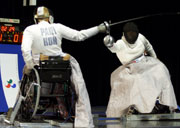Wheelchair Fencing
Fencing is a sport that calls for adaptability, inventiveness, good
organisation, and patience. In order to
master it, the fencer spends long hours
practicing.
 The
athletes in Paralympic fencing are those
with locomotor disabilities. They compete on
wheelchairs. During a bout the wheelchairs
are fixed to the ground. This nevertheless
allows the fencer the freedom to execute
rapidly alternating movements. The
athletes in Paralympic fencing are those
with locomotor disabilities. They compete on
wheelchairs. During a bout the wheelchairs
are fixed to the ground. This nevertheless
allows the fencer the freedom to execute
rapidly alternating movements.
The sport is governed by the rules of
FIE, the International Fencing Federation,
and of the Fencing Committee of the
International Paralympic Committee.
There are five fencing events in the Olympic
Games, and each can be an individual event
or a team event:
Fencing at the
2004 Paralympic Games
Fencing at the Paralympic Games in Athens
will be held at the
Fencing Hall - Preliminaries Terrain of
the Helleniko Olympic Complex. The
competition programme will be completed
within six days, from 18 to 24 September
2004. |
|
|
|
|
|
|
|

